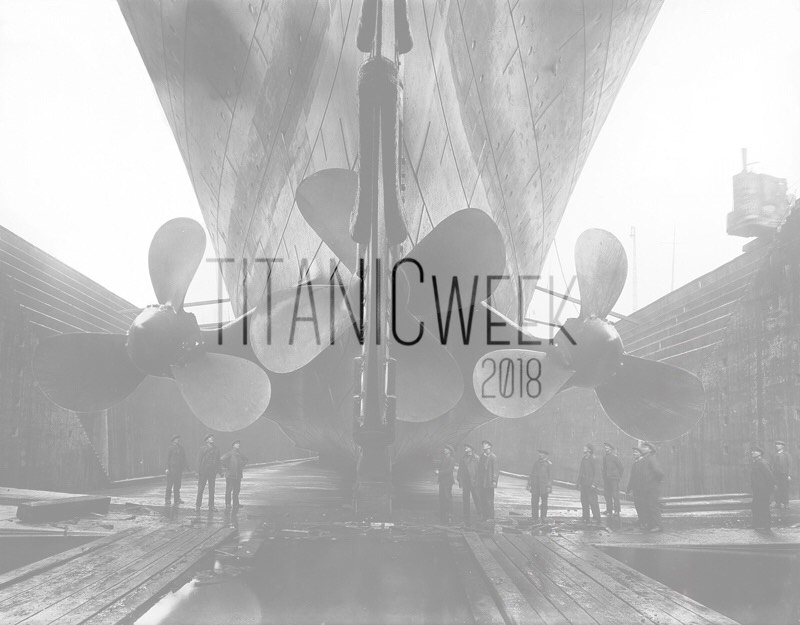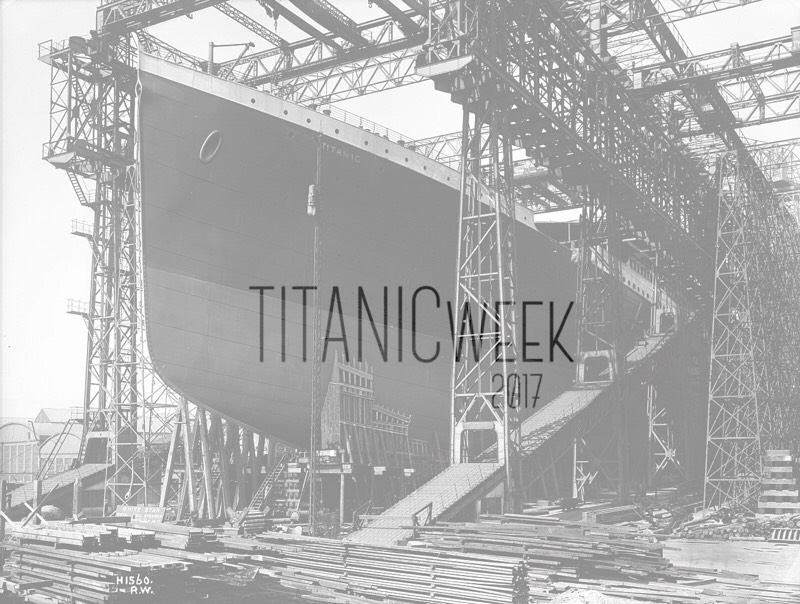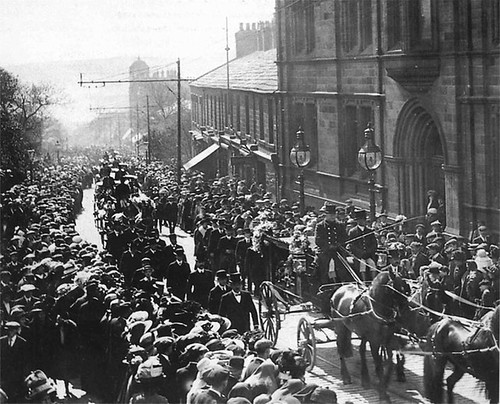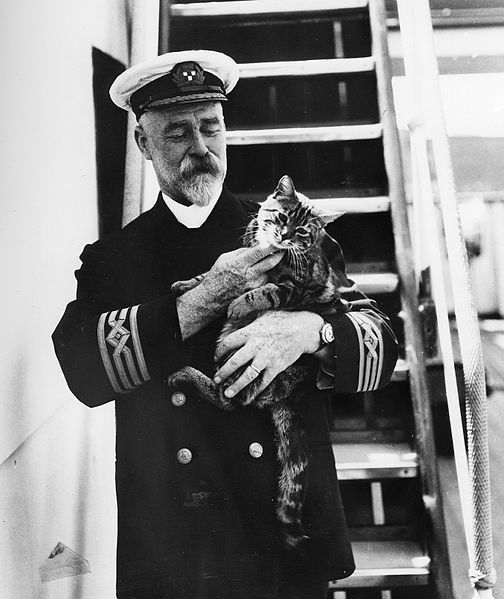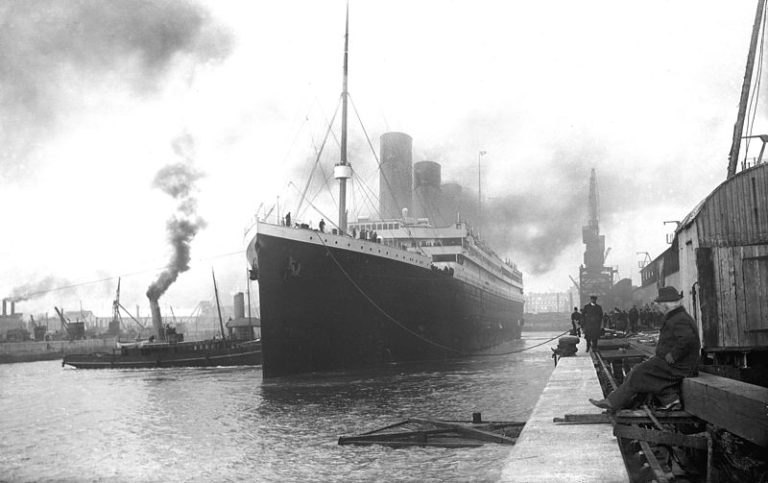SS401 & Shipyard Casualties
Titanic, along with her sister vessels the Olympic and Britannic, were constructed in Belfast, Ireland. Belfast was an industrial city, and jobs were labor-intensive. And thanks to Belfast's ship-building company, Harland & Wolff, the construction of the behemoth liners was a city-wide operation that everyone talked about morning, noon, and night.
Belfast women primarily worked in the local linen industry, and their men were localized to the Harland & Wolff shipyards. These ladies were nicknamed "Millies," and the 15,000 men employed by Harland & Wolff worked in "The Yard."

Workers "knock off" at the Harland & Wolff shipyard, with Titanic in the background, circa May 1911.
Belfast women primarily worked in the local linen industry, and their men were localized to the Harland & Wolff shipyards. These ladies were nicknamed "Millies," and the 15,000 men employed by Harland & Wolff worked in "The Yard."

Workshop at Harland & Wolff shipyard at Queen's Island, Belfast. Taken by Robert John Welch for Harland & Wolff, circa 1910.
Shipyard workers had 6am-5:30pm hours, Monday through Saturday. After work on Saturday, many often headed off to rally for the Glens--their shipyard football team--at The Oval, a local stadium, in a game against their local rivals, the Linfields. Then they would go on to exalt or lament in local pubs through East Belfast later in the evening. Rinse, repeat.
Sunday, of course, was for church. But for some, God could wait. According to Francis John Parkinson, Jr., who was less than five years old at the time and whose father was a woodworker for Titanic.
"I can well remember one Sunday afternoon, my father said... 'You tell your Sunday School teacher you'll not be in Sunday School next Sunday, for your dad's going to take you down to see the Titanic at Harland & Wolff.'"
"I remember looking up at this big steel hulk... and he described to me how someday they'll take away all the timber props that held up the ship, and they would release it into the water. And I remember quite well saying, 'But Dad, how can that big ship stay up in the water?' 'Oh,' he said, 'that ship will always stay up in the water. It will always stay up.'"
From "Titanic: The Complete Story" (formerly "Titanic: Death of a Dream) © A&E Television Networks, 1994.
Parkinson's warm confidence speaks to the comeraderie felt throughout Belfast.
Building these ships was an extremely personal and sentimental effort for the thousands of people employed and bearing witness to their construction. Thomas Andrews, the ship's designer, was regularly found walking through The Yard with plans in his pockets, to talk with and best appreciate his workforce.
Contrary to popular imagination, White Star did not declare Titanic unsinkable. But a periodical called "The Shipbuilder" did. Therein, the RMS Titanic was pronounced "practically unsinkable" due to its novel fittings--such as the three-propeller system and fancy boilers--and its safety features, such as its watertight compartments and double hull, which would theoretically allow it to float even in spite of a crash.

Cross-section of Titanic, illustrating double hull plating. Published by Harland & Wolff, circa 1912. Courtesy of Internet Archive Book Images.
One of the reasons safety regulations are so stringent today is because up until recent history, they didn't exist at all. If you crushed a finger, lost an arm, burnt your face on duty? That was the hazard of the job; wish your livelihood farewell. And a number of men, often referred to as Titanic's First Victims, were subject to that reality.
A total of eight shipyard men died during the construction of the world's finest ocean liner, although some could hardly be called that. Samuel Scott was the youngest at only 15 years old; John Kelly, 19. Many workers in the shipyard were as young as 13.

Riveters on the deck of a ship in Harland & Wolff's shipyard in Glasgow, Scotland, during the First World War. Courtesy of Imperial War Museum Photograph Archive Collection.
Samuel lived on his own down the street from his mum, who was listed in contemporary census as having six of her children living with her; in addition, the Scotts shared the house with another couple, who had three children themselves. Having the elders clear out to make space was common practice at the time, despite how objectively young Sam was.
On April 20, 1910, Sam was working on SS 401. As everyone did, Sam lined up to get his "bourd," the bit of wood with his assigned ship's number written on it. Sam was what they called a "catch boy" at The Yard, working as part of a riveting crew.
Essentially, the rivets were stoked in a coal bucket to white-heat by the "bellows boy;" the rivets were then removed with tongs and immediately tossed high in the air up to Sam, who caught them with his tongs and placed them in the hull so another boy, the "holder on," could keep it in place while it was driven in with a sledge hammer, and then a bevy of boys with hammers would alternatively work away at the still-cooling rivet to mold it into shape.
The boys were paid per rivet, so the smoother the teamwork, the hIgher the profit. But, if stories up from the ground and just a little clumsy, a catch boy could lose his job. Or his life.

Titanic and her elder sister, Oylmpic (foreground) under construction. Taken by Robert John Welch for Harland & Wolff, circa 1910. From the George Grantham Bain Collection, courtesy of the Library of Congress
High up alongside SS 401 on April 20, 1910, Sam slipped from a ladder on staging stories above the ground, and fell to his death; according to the inquiry performed as a result, no one witnessed his actual fall. His death was attributed to shock from fracture to the skull.
Sam was buried in an unmarked grave, but in 2011, Belfast historical organizations endeavored to get Sam a headstone.
Samuel Scott was one of eight to die building SS 401--the ship that a year following his death would be launched and christened the Titanic--but he's only one of five whose names we know. Three men are still unidentified. In spite of this, the Harland & Wolff Football and Social Club commissioned a commemorative plaque, which was dedicated in 2012.
SOURCE MATERIAL
[ital]
